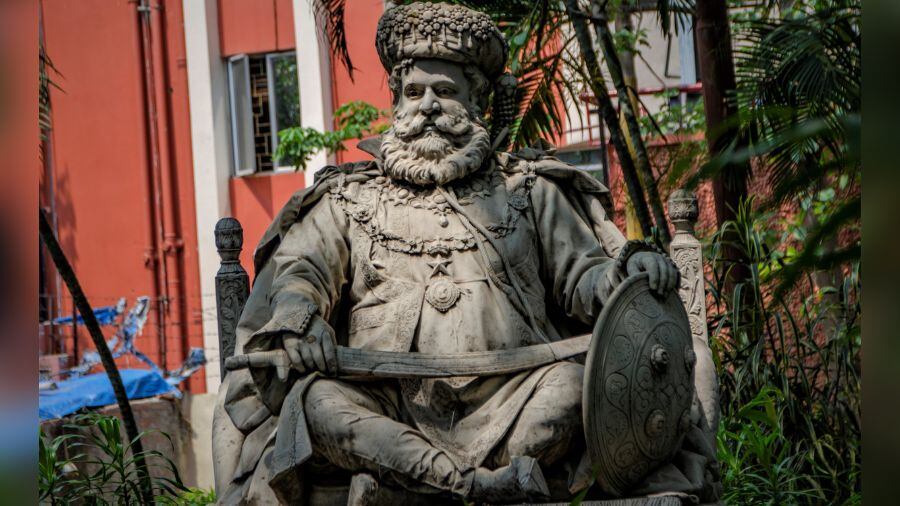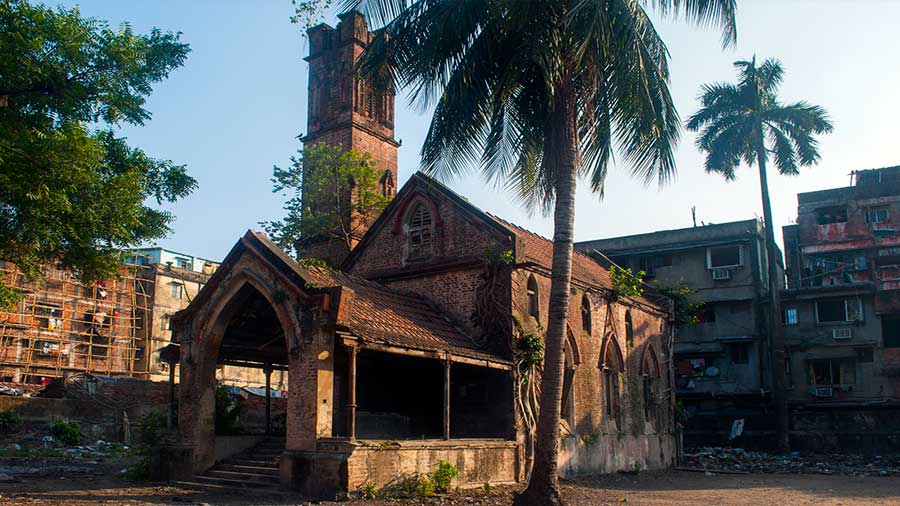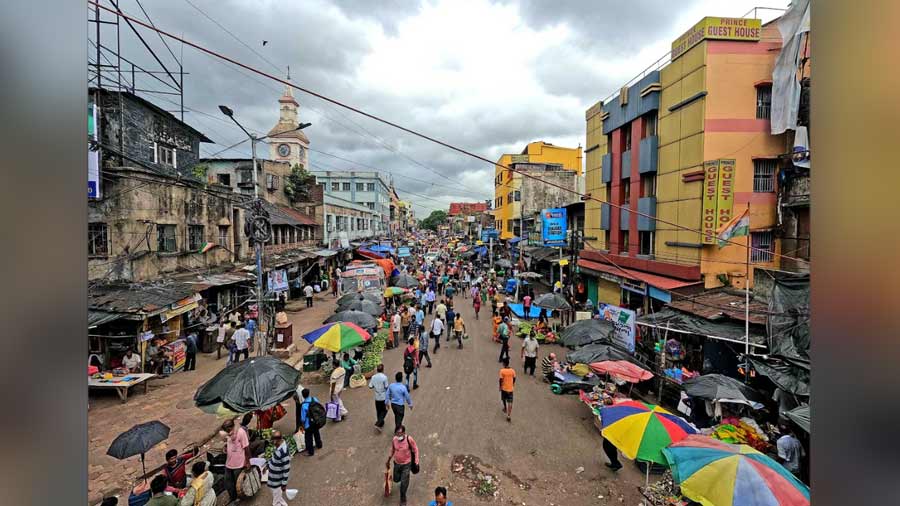Within 50 years of winning the Battle of Plassey, the East India Company began decorating Calcutta with parks, gardens, colossal buildings built in an Indo-European style, many with waterbodies.
In addition to the architecture, came the marble statues. Calcutta got its first full-figured colonial statue in 1803, when a marble statue of Lord Cornwallis was imported from London and placed in Fort William.
It was moved to Town Hall 10 years later and then in 1920, it found a home at Victoria Memorial. The city soon had a collection of stone and bronze statues, and by the beginning of the 20th century, was dotted with many magnificent statues — mostly of British royals. In 1881, a marble statue of Ramanath Tagore, who was the stepbrother of Prince Dwarkanath Tagore, was also imported from London.

Dalhousie Square, 1944 The Hensley Photo Library, Digital South Asia Library
The maharaja arrives
In 1904, another Indian figure found a place in this collection. At the southwest corner of Dalhousie Square (near the HSBC building), a small yet elegant statue was installed by the British government — this time featuring an Indian maharaja.
On March 25, 1904, Sir Andrew Fraser, Governor of Bengal, and other British officials assembled to unveil the statue of Lakshmeshwar Singh Bahadur, Maharaja of Darbhanga. Noted Indians like Sir Gurudas Banerjee were also present at the event.
Indian maharajas were often the object of profound inquisitiveness among the European population. This statue, installed in an important place like Dalhousie Square of Calcutta — the capital of British India and then financial hub of east Asia — brought dignity and respect to the clan of Indian maharajas.
The installation of this statue at Dalhousie square was no ordinary event, and neither was the man himself.
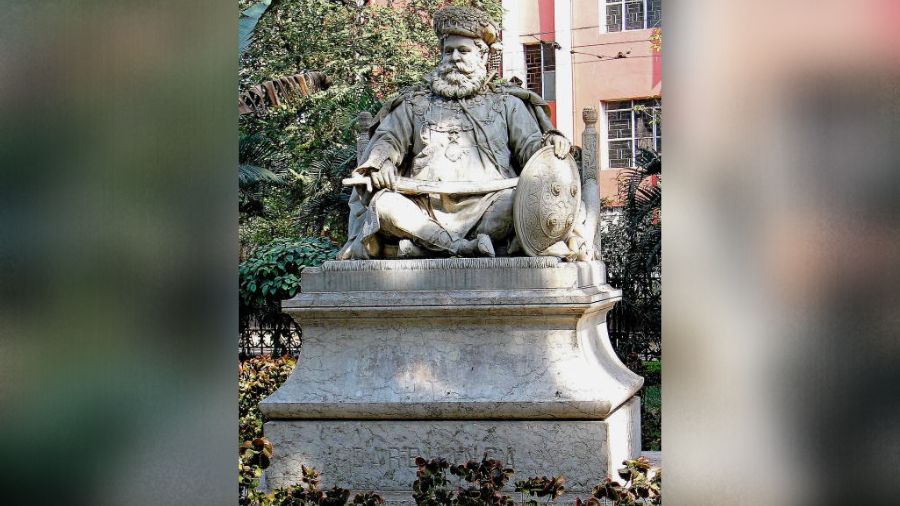
The task of making his statue was entrusted to famous British sculptor Edward Onslow Ford and is made in white marble Robert Freidus
The Maharaja of Darbhanga
Born on September 25, 1858, to the royal family of the Khandaval, who had a huge zamindari estate in Bihar’s Darbhanga, Lakshmeshwar was among the first few of his Maithili Brahmin family to have a western education. This made him an iconoclast as soon as he wore the crown at a very young age. The young maharaja spent a lot of money in establishing a modern clinic at Darbhanga and also donated generously during the Bihar Famine of 1873-74.
He was a philanthropist and a patron of the University of Calcutta, and donated generously to the university. In fact, one of the prime buildings of the university’s College Street campus is named Darbhanga building. He was among the founding members of the Indian National Congress and in 1892, helped the newly formed organisation at great personal risk when he arranged its conference venue despite the threats from the British government. Though a member of the Imperial Legislative Council — a coveted post given for showing loyalty to the British — he was a patriot at heart and raised his voice for the sake of his countrymen.
Lakshmeshwar lived a short life and died in 1898 at the age of 40. The statue was installed as a token of respect after his passing.
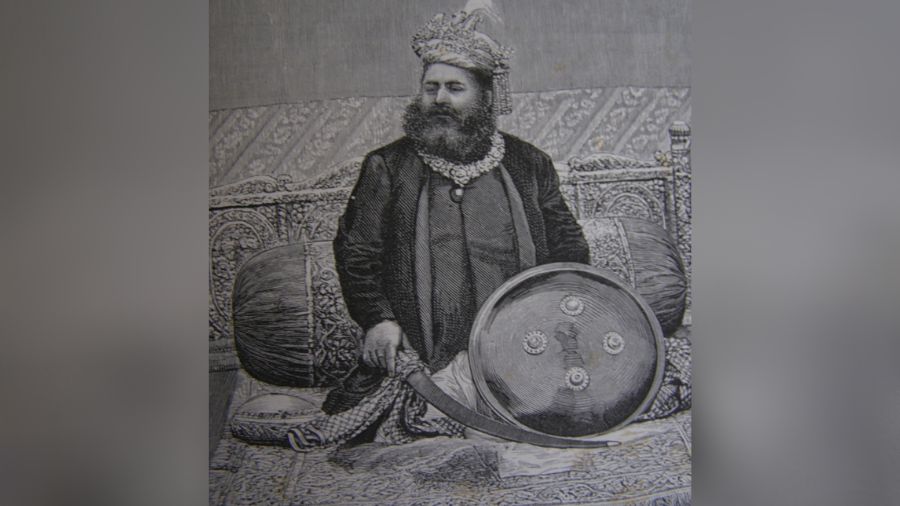
Lithograph print of Maharaja Lakshmeshwar Singh published in Graphic Magazine, 1888 Wikimedia Commons
The making of the statue
The task of making his statue was entrusted to the famous British sculptor Edward Onslow Ford, who used white marble to create it. A photograph of the ruler seated on the floor was used as reference, and the statue was made in England and shipped to Calcutta.
In the image, the king, who was knighted by the queen, is seen in royal attire, wearing his gem-embellished turban. His clothing displays the Knight Grand Commander of the order of the Indian Empire. He is seated cross legged on an ornamental throne and is holding a sword in his right hand that rests on his knee, and a shield in his left hand.
Not so impressive?
Ford’s work, though impressive, has been ridiculed by some for one feature. Famous cartoonist P.K.S. Kutty, who was on a tour of the statues of Calcutta for a book, pointed out that the statue does not look like a man who died at the age of 40, but seems like that of an old man. He also pointed out that Indians, while sitting on the ground cross legged, never keep their shoes on.
The earliest available photograph of the statue can be found in Calcutta Municipal Gazette from the 1920s. It shows the statue placed on a high podium and fenced by a beautifully crafted iron railing, part of which was later stolen and then all of it removed.

The photograph by T.P. Sen in the Calcutta Municipal Gazette in the 1920s Courtesy Somen Sengupta
Though a significant part of the city’s history, there’s been no limelight on this statute. Finding it is difficult, as it stands in a corner now overgrown with trees and discarded things. However, thanks to the growing popularity of heritage walks in the Dalhousie area, the statue is often spotted and a short narration is offered to the walkers by the guide.
As Dalhousie square hopes to win a UNESCO World Heritage tag, small yet rich relics like this are the first ones in need of care.
